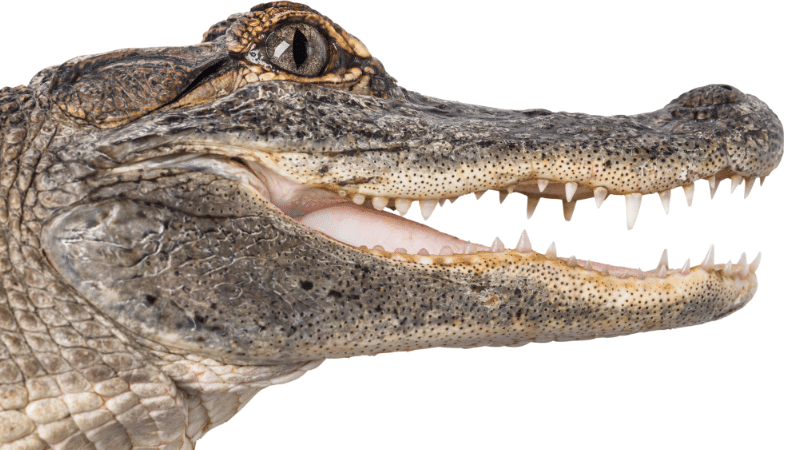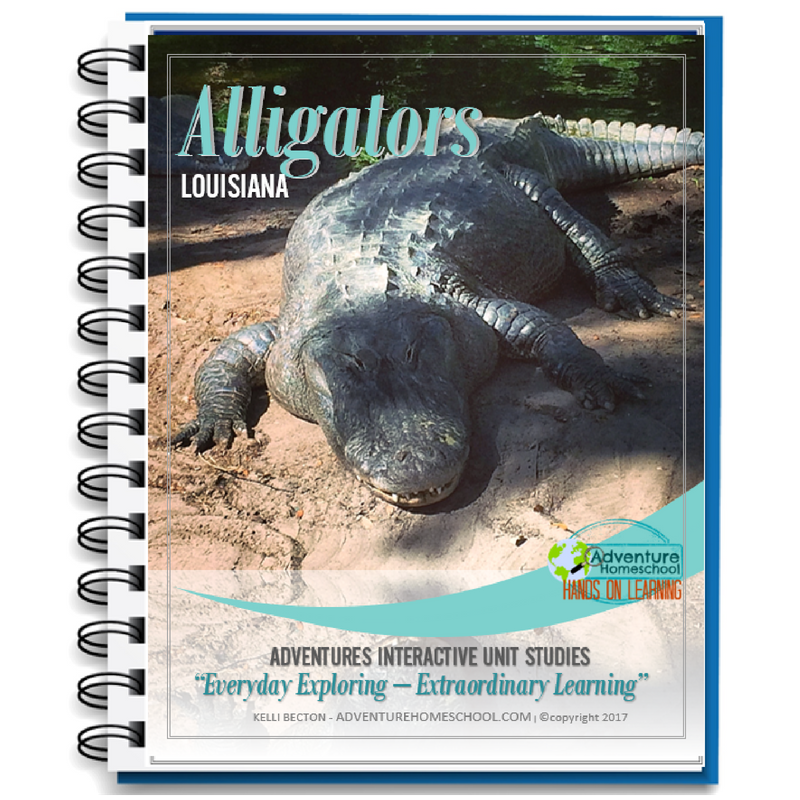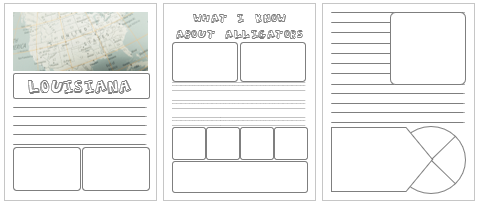
In this American Alligator Mini Unit, you’ll learn interesting facts about the alligator. Additionally, you can download free Notebooking pages to record what you’ve learned.
American Alligator Mini Unit
The American alligator is the largest reptile in North America. The name ‘alligator’ derives from the Spanish ‘el lagarto’ meaning ‘the lizard’.
Though often confused with various crocodile species, the American alligator can be distinguished by its rounded snout, and by the fact that when the jaws are closed, none of the lower teeth are visible. The American alligator’s jaws contain between 74 and 80 sharp teeth.

Gator Characteristics
They are capable of delivering a mighty bite force when slamming jaws shut, but are much weaker when opening the mouth. Often you will see a “gator” sitting very still with its mouth open – waiting on prey to come close enough to its massive jaws.
Additionally, the body is armored with thick scales, and includes a long tail, that is extremely powerful. It also possesses sturdy limbs with webbed toes, which help to propel this species through the water as well as on land.
Above all, the alligator is designed by the Creator with eyes and snout positioned on the top of the head. As a result, the gator is able to breathe and watch for prey with its body fully submerged underwater. The coloration of the body, which is black or a dark olive-brown in the adult, along with the ability to stay submerged, in part – or as a whole, makes the alligator a master of disguise.
The clever camouflage helps it sneak up on prey, also it helps them hide from humans – which are the only real predators of the alligator. The younger specimens possess yellow banding across the body and tail and are carried in the mouth and jaws of the mother alligator after hatching.
Alligators Video
American Alligator as a Predator
An opportunistic predator, a fully-grown American alligator is capable of tackling nearly all aquatic and terrestrial prey that it encounters. Hatchlings start life feeding on insects and freshwater shrimp, but as they grow they graduate to larger prey, taking fish, frogs and snakes, and eventually small to large mammals. Although a ferocious predator, attacks on humans are rare and usually take place only when a gator has been fed, or someone swims in unclear water at night or during mating season.
A female lays between 25 and 60 eggs in a large, torn-up mound of vegetation and mud situated on a bank. The eggs are deposited within a depression in the top of the mound, which is then covered over with more vegetation.
Louisiana – Home to Many Alligators
The state of Louisiana is known for its swamps, which are home to many alligators. Louisiana is located in the southern region of the United States. Its capital is Baton Rouge. The largest city, and one of the most famous is New Orleans.
Find Louisiana on the USA Map below (hint – the state abbreviation is LA):

Louisiana is located between Texas and Mississippi in the southern part of the United States.
Alligators in Louisiana
So, alligators have been harvested for some 200 years. They were first harvested in Louisiana in great numbers in the early 1800’s because gators were hunted for their skins to make boots, shoes and saddles. The oil harvested from the alligators was used to grease steam engines and cotton mills.
You see, boots and saddles from alligator skins were in high demand during the Civil War. Additionally, by the late 1800’s and early 1900’s alligator skins were being processed in great numbers in commercial tanning warehouses. This process made the skins softer and more durable. By the mid 1900’s, the alligator population in Louisiana had been greatly reduced. In 1962, alligator hunting season was closed statewide in order to save the species.
Today, alligator hunting is allowed in Louisiana (and Florida) but is carefully regulated by each state. Through research, preservation, and management, Louisiana’s alligator population has stabilized.
See Adventures Full Alligator Unit Study HERE
 Alligator Unit Study – Louisiana
Alligator Unit Study – Louisiana
- Bible Study – Courage
- Language Arts – Wordsworth poem, vocabulary, John James Audubon biography (Audubon based in Louisiana) and more
- Geography – Louisiana state study, habitat of alligators
- History – New Orleans, Louisiana, Alligators in history & Audubon study
- Science – Several lessons: Alligators, design in Creation, more
- Reading – woven throughout the unit as well as optional book list
- Teen activities – Powerpoint, videos, research paper and project to discover how colleges put scientific studies together.
- Cross lateral learning – Projects and activities to help students with dyslexia and all different types of learners understand and retain materials.
- Kids in the Kitchen – other hands on learning, traditional Louisiana cooking.
- Bonus material – loads of interactive materials and projects included as well as a full Audubon study. Did you know the National Audubon Center is located in New Orleans?
- Hands on Learning – build a solar oven, ID game for mammals – reptiles – amphibians – birds – insects – fish, design an AD, clay project, and more!
Free Notebooking Pages
Download this free set of notebooking pages in order to use with the alligator mini unit study.
Sample Pages


FREE SHIPPING and bonus digital package to help with homeschooling. Includes Kitchen Binder Builder and more!
Save $35
Sale Price $125
with Coupon only $105 and Free Shipping!
Enter Code: SPRING at checkout
Limited Time
GREAT Bundle of resources for you to discover companies you like by trying curriculum for FREE! Additionally, most companies have left coupon codes for you to save on more items in their stores if you like what you see.

